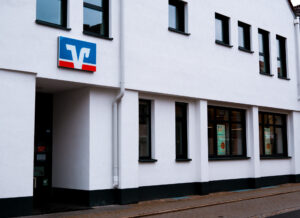Table of contents
ToggleIn many industries, including retail, budgets are currently being cut, projects stopped and important decisions postponed. The energy crisis, the threat of recession, climate change - there are many arguments against investing in digital signage at the moment. However, technological progress offers many options for using these issues not as showstoppers, but as catalysts for future digital signage concepts. A PwC study supports that 73% of all retail customers see the experience as the most important factor for their purchase decision - even before costs and product quality. (1) Digital signage can therefore play an important role here.

What is digital signage anyway?
Digital signage is a form of electronic display used to convey information, news and advertising to a specific audience. LCD, LED or projection screens are typically used for this purpose, which can be controlled and updated via a computer or other device. Digital signage can be brought into a variety of environments, including retail stores, restaurants, airports, and public spaces. They can be used to display a wide range of information, including text, images, videos and animations, and can be customized and updated in real time. Digital signage is often seen as an effective and engaging way to communicate with customers and other audiences, and can help businesses improve the customer experience, increase sales, and promote their products or services.
What dependencies exist in order to be able to use a digital signage solution in a targeted manner?
There are several key requirements for the proper use of digital signage. Some of the most important requirements are:
- Reliable and high-quality displays: Digital signage solutions depend on the quality and performance of the display technology. Therefore, it is important to use screens that are capable of delivering clear, sharp and consistent images and video to ensure high-quality content. Regardless of whether the content is used indoors or outdoors.
- Access to high-speed Internet: Since digital signage solutions often stream and display large amounts of data, a fast and stable Internet connection is important to ensure that content can be transmitted and displayed without interruption.
- Robust and scalable content management system: Digital signage often displays large amounts of content that can be difficult to manage and update manually. A content management system can help organizations organize and manage their digital signage content, providing tools for creating, scheduling, and distributing content.
- Support from experienced providers and partners: Digital signage can be complex and technically demanding. That's why it's important to work with a digital signage provider and partner who have experience and expertise in the field. These digital signage providers can assist and advise on everything from selecting the right displays and hardware to developing and implementing a successful digital signage strategy.
- Flexibility and adaptability: Because a company's needs and goals can change over time, it is important that digital signage systems are flexible and adaptable. This allows companies to adapt to in-store marketing, changing customer needs, market conditions and business goals, and ensure that their digital signage investments continue to be useful over time.
What are the most important trends in the use of digital signage?
The use of digital signage systems is growing rapidly, and there are a number of key trends and innovations driving this growth. Some of the top 5 trends in digital signage usage are:
- Increased use of interactive and personalized content: Digital signage systems are used to offer customers individualized content with which they can interact via a touchscreen, for example. In addition to information systems, this includes personalized recommendations, interactive games and quizzes, and personalized offers and coupons.
- Omnichannel experience growth: Digital signage is used to create seamless omnichannel experiences by providing a consistent brand experience across multiple channels and touchpoints. This includes, for example, digital signage at POS connected to online shopping platforms, or digital signage integrated with mobile apps and other digital tools.
- Expanding the use of existing video content: Digital signage systems are increasingly being used to display existing video footage, such as product demonstrations, customer testimonials, and behind-the-scenes footage, with the goal of providing value and info. This can help engage customers and provide a more immersive and interactive experience through content.
- Use of AI and machine learning: Digital signage is powered by AI and machine learning to optimize content and deliver personalized and dynamic content based on audience preferences and behavior.
- Increasing use of outdoor digital signage systems: Digital signage is also being used in outdoor locations, such as shop windows, shopping malls and public events. This can help increase brand visibility and reach a wider audience.
Overall, these trends are driving the growth of digital signage and helping companies create more engaging and personalized experiences for their audiences. Have you already implemented a trend?

Is digital signage generally more sustainable than traditional advertising media?
Digital signage can be more sustainable than traditional advertising media in several ways. One of the main benefits of digital signage is that it is more energy efficient than traditional signage, which can help reduce greenhouse gas emissions and other environmental impacts. Digital signage also has a longer lifespan than traditional advertising media, which means it doesn't need to be replaced as frequently, eliminating waste and saving resources. In addition, digital signage allows companies to easily and quickly update their media content, which can reduce the need for print and other materials and make it easier to reuse or recycle content when it is no longer needed. Overall, digital signage, while not completely sustainable, can be a more sustainable option than traditional signage and advertising in many cases.
How do LED and LCD displays differ in terms of sustainability?
LED and LCD displays are two different technologies commonly used for digital signage and other applications. Both technologies have their own advantages and disadvantages in terms of sustainability.
LED displays are often considered more sustainable than LCD displays because they are more energy efficient and have a longer lifespan. LED displays use light-emitting diodes (LEDs) as a light source, which are more efficient and generate less heat than the fluorescent lamps or cold cathode tubes used in LCD displays. This means that LED displays typically use less power and generate less heat, which can help reduce greenhouse gas emissions and other environmental impacts. In addition, LED displays typically have a longer lifespan than LCD displays, which means they do not need to be replaced as frequently, reducing waste and saving resources.
However, LCD displays also have some sustainability advantages over LED displays. LCD displays are typically made from fewer materials and are easier to recycle than LED displays, which can reduce the environmental impact of their disposal. In addition, LCD displays do not contain toxic substances such as mercury, which are used in some LED displays, making them more environmentally friendly. Overall, both LED and LCD displays have their own strengths and weaknesses in terms of sustainability, and the most sustainable option will depend on the specific circumstances and company goals.
Digital signage for your company?
We offer an individual, tailor-made full service for your digital signage project, including conception,
implementation and after-sales service. Contact us without obligation for an initial consultation.
What is the typical lifespan of digital signage?
The lifespan of digital signage systems depends on a number of factors, such as the quality of the screens and other hardware, usage patterns, the environment in which they are deployed, and the level of maintenance and care. In general, digital signage systems are designed to last several years, with some systems lasting up to 10 years or more. However, the exact lifespan of a particular digital signage system will depend on how it is used and maintained, and may be shorter or longer than the average lifespan. It is important that companies carefully consider the lifespan of their digital signage systems when making purchasing decisions and plan for regular maintenance and replacement as needed.
What about energy efficiency?
There are several ways companies can save energy when using digital signage. One way is to use energy-efficient display technologies, such as LED or OLED displays, which consume less power than traditional screens. In addition, companies can use the power management settings on their displays to automatically turn off the screens when not in use or dim the screens when ambient light is low. Furthermore, companies can use software and hardware solutions to remotely monitor and control their digital signage networks to identify and address inefficiencies or issues that are causing excessive energy consumption. Finally, companies can consider using renewable energy sources, such as solar power, to power their digital signage systems to reduce their carbon footprint and contribute to a more sustainable future.

How can digital signage and content be used recurrently?
There are various reuse scenarios for a digital signage system, depending on the circumstances and the type of content displayed. For example, digital signage content can be easily reused and repurposed in other contexts, such as social media or other digital screens. This can help save time and resources by not having to create new content for each use. In addition, digital signage content can be archived and retrieved at a later date, which can be useful for organizations that want to reuse seasonal or event-specific content, or for those that want to keep a record of their previous content. Finally, digital signage hardware can often be reused or resold to other organizations when it is no longer needed, extending its life and reducing waste. Overall, digital signage solutions offer many opportunities for reuse and recycling, saving organizations time, resources and money.
Is an investment in digital signage an additional risk with a recession looming?
Investing in digital signage solutions during a recession can be seen as a risk for businesses, as economic downturns can often lead to decreased consumer spending and demand for goods and services. However, digital signage can also provide benefits and opportunities for businesses during a recession that can help mitigate the risks. For example, digital signage can be a cost-effective way for companies to advertise their products or services, which can help them generate more sales and revenue. Digital signage installation, with the right content management, can also help companies improve their customer experience, which can help them retain customers and build loyalty during tough economic times. In addition, digital signage software including digital signage can be used to provide real-time information such as news and updates, which can be valuable to customers and help businesses maintain a positive and engaging presence in the marketplace. Overall, the risks and benefits of investing in digital signage during a recession depend on the specific circumstances and the goals of the business.
Conclusion
Despite all the current headlines, digital signage can have a real added value for companies and the rapid technical developments provide ever new arguments for targeted use of these solutions.
Our team of experts is constantly visiting trade fairs such as ISE in Barcelona and will report on the latest developments and benefits of digital signage, as well as trends from the industry.
Is digital signage also interesting for you?
We offer an individual, tailor-made full service for your digital signage project, including conception, implementation and after-sales service. Contact us without obligation for an initial consultation.







